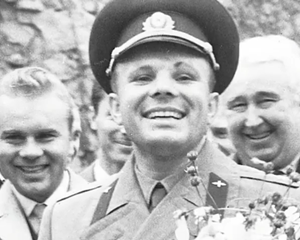In September, 1961, Gagarin was in Crimea for yet more celebratory parties.
1961年9月,加加林在克里米亚参加了更多的庆祝派对。
Sozzled out his mind, he followed a gorgeous young blonde named Anna back to her hotel room on the second floor.
他头脑昏昏沉沉的,跟着一个名叫安娜的漂亮金发女郎回到了她在二楼的酒店房间。
When Valentina burst in, the spaceman tried to escape by leaping out the nearest window, only for his foot to catch and send him plunging headlong to Earth.
当瓦伦蒂娜闯入时,加加林试图从最近的窗户跳出来逃跑,结果他的脚被抓住了,他头朝下坠落到了地球上。
The cracked concrete impacted sickeningly against Gagarin's forehead, leaving him permanently scarred.
裂缝的混凝土撞击着加加林的前额,给他留下了永久的伤疤。
When he came to in the hospital, his brain was so scrambled he initially thought he'd never fly again.
当他在医院醒来时,他的大脑非常混乱,一开始他以为自己再也不能飞行了。
But, no. The gods were, for now, still smiling down on the former farm boy.
但是,并没有。目前为止诸神还在微笑着看待这个曾经的农家男孩。
Not long after this, Gagarin abandoned his new life as a global celebrity, and returned to working on the Soviet space program.
此后不久,加加林放弃了作为全球名人的新生活,回到苏联太空计划中工作。
This world of parties wasn't for him.
这种派对的世界不适合他。
He was still less than 30. He had infinitely more missions left to fly, infinitely more rockets to pilot. Didn't he?
他还不到30岁。他还有非常多的任务要执行,还有非常多的火箭要驾驶。不是吗?
If Yuri Gagarin's early life was the good side of the Soviet dream, plucking a talented peasant boy from obscurity and taking him to the stars; the last years of his life showed its nightmarish side.
如果尤里·加加林的早期生活是苏联梦美好的一面,把一个才华横溢的农家男孩从默默无闻中拉出来,带他登上星空。那么他生命的最后几年展现了噩梦般的一面。
In early 1967, the new Soviet leader, Leonid Brezhnev, made it known that he wanted something spectacular to mark 50 years of Communism.
1967年初,苏联新领导人列昂尼德·勃列日涅夫宣布,他想要一些壮观的东西来纪念共产主义成立50周年。
The idea was to send up two Soyuz rockets a couple of days apart, symbolizing Soviet supremacy.
他们的想法是在几天内分别发射两枚联盟号火箭,象征着苏联的霸权。
At first, Gagarin was excited. He pulled some strings and got himself selected as backup pilot, just in case his fellow cosmonaut Vladimir Komarov fell ill.
一开始,加加林很兴奋。他动用了一些关系让自己被选为候补飞行员,以防他的同伴弗拉基米尔·科马罗夫生病。
But, as the date approached, that excitement turned to fear.
但是,随着日期的临近,这种兴奋变成了恐惧。
A technical team identified 203 faults that needed urgent attention.
一个技术团队发现了203个需要紧急处理的故障。
Gagarin helped them prepare a ten page report for the leadership at Baikonur to send to Moscow.
加加林帮他们准备了一份10页的报告,交给拜科努尔的领导层,然后送到莫斯科。
But when the report was finished, he discovered something truly terrifying. Everyone was too scared to send it.
但当报告写完后,他发现了一些真正可怕的事情,大家都怕得不敢去送。
With Brezhnev in charge, the Soviet system had returned to its cruelest ways.
勃列日涅夫掌权后,苏联的体制又回到了最残酷的状态。
Shooting the messenger was now practically a sport, and no-one wanted to be the bearer of bad news.
射杀信使几乎成了一种运动,没有人愿意成为坏消息的传递者。
As the launch date approached, Gagarin seems to have realized that getting in the rocket would be a death sentence.
随着发射日期的临近,加加林意识到进入火箭将是一个死刑判决。

He begged a KGB friend of his to take the negative report to his superiors.
他求他的一个克格勃朋友把这份负面报告交给他的上级。
The friend at last agreed, went to upper command… …and disappeared.
朋友终于同意了,去见了上级…… ……然后消失了。
He, and everyone who'd seen the report, were all summarily fired or sent to work in humiliating postings in the arse-end of Siberia.
他和所有看过这份报告的人都被立即解雇了,或者被派到西伯利亚的穷乡僻壤去工作。
With Brezhnev in charge, rocking the boat simply meant you drowned.
在勃列日涅夫的领导下,摇船就意味着你会被淹死。
On the day of the launch, Gagarin accompanied Komarov to the rocket pad. There, Gagarin had a moment of heroism.
在发射当天,加加林陪同科马罗夫前往火箭发射台。在那里,加加林彰显了一个英雄的时刻。
He kicked up a massive stink, demanding he be put in that rocket, shouting that it was his right as as Komarov's superior…
他大呼小叫着,要求把他放进火箭里,大喊着这是他的权利,就像科马罗夫的上级一样……
But, no. Komarov didn't fall for it.
但是,没有,科马罗夫没有上当。
Instead, he said goodbye to Gagarin, and clambered into his execution chamber.
相反,他和加加林说了再见,爬进了他的行刑室。
Komarov's wife was in the control room, and they spent the minutes before launch saying goodbye over the radio,
科马罗夫的妻子在控制室里,发射前的几分钟他们通过无线电告别。
aware the cosmonaut wasn't coming back, but unable to do anything to stop this horrific chain of events.
虽然意识到加加林不会回来了,但却无法做任何事情来阻止这一连串可怕的事件。
And so, on April 27, 1967, Yuri Gagarin was forced to stand helpless on the ground as the Soyuz carrying his friend failed in mid-air, reducing Vladimir Komarov to ash.
因此,1967年4月27日,尤里·加加林被迫无助地站在地上,因为载着他朋友的联盟号飞船在空中失败,弗拉基米尔·科马罗夫化为灰烬。
The cosmonaut never got over what had happened that day. The wide smile faded, replaced by a morose expression.
自此加加林一直无法从那天发生的事情中恢复过来。他那灿烂的笑容消失了,取而代之的是一个忧郁的表情。
Openness gave way to depression. Maybe it wouldn't have lasted. Maybe Gagarin's sunny side would have returned eventually.
开放让位于萧条。也许不会持续太久,也许加加林阳光的一面还会回来。
But we'll never know. On March 27, 1968 - 11 months exactly after Komarov's crash - Gagarin jumped in a MiG-15 for a routine flight.
但我们永远猜不到,1968年3月27日,也就是科马罗夫坠机的11个月后,加加林跳上一架米格-15进行常规飞行。
96km northeast of Moscow, he crashed at high speed. The impact killed Gagarin instantly.
在莫斯科东北96公里处,他高速坠毁。撞击使加加林当场死亡。
Aged just 34, the first spaceman was no more.
年仅34岁的第一个太空飞行员就这样离开了。
At the time, there were endless conspiracy theories surrounding Gagarin's death.
当时,关于加加林之死的阴谋论层出不穷。
But, in 2013, formerly classified files were released showing that it was just another case of Brezhnev-era mismanagement.
但在2013年,一些曾经属于机密的文件被公开,显示这只是勃列日涅夫时代又一个管理不善的例子。
That same day, an SU-15 jet had accidentally flown too low, passing incredibly close to Gagarin's MiG.
同一天,一架苏-15喷气式飞机意外飞得太低,和加加林的米格战机极其接近。
The huge aircraft had rolled Gagarin's jet, causing it to spin out of control, sealing his fate.
这架巨大的飞机辗过了加加林的喷气式飞机,导致飞机失去控制,决定了他的命运。
Yuri Gagarin's ashes were interred in the Kremlin Wall in Moscow on March 30, 1967, following a huge memorial parade.
1967年3月30日,尤里·加加林的骨灰被安葬在莫斯科的克里姆林宫红场墓园,随后举行了盛大的纪念游行。
Shortly after, his teenage hometown changed its name from Gzhatsk to Gagarin in his honor.
不久之后,为了纪念他,他十几岁时的家乡把名字从“斯克”改成了“加加林”。
Today, over half a century since Gagarin's untimely death, it can still be hard to fully wrap your head round his achievement.
今天,在加加林英年早逝半个多世纪后,你仍然很难完全理解他的成就。
While Neil Armstrong's moonwalk first is probably more famous in the west, Gagarin's flight was arguably far more impressive.
虽然尼尔·阿姆斯特朗的月球漫步在西方可能更为出名,但加加林的飞行可以说更令人印象深刻。
Prior to that spring day in 1961, no human had ever done anything beyond the confines of our Earth.
在1961年那个春日之前,人类从未在地球之外做过任何事情。
Every technological revolution, every great explorer, every brilliant scientist, all had been limited to this one pale speck in the cosmos.
每一场技术革命,每一个伟大的探险家,每一个杰出的科学家,都局限于宇宙中的这个苍白的小点。
And then came Yuri Gagarin. The moment the cosmonaut reached orbit, a new horizon opened for humanity.
然后是尤里·加加林。在他到达轨道的那一刻,人类的新视野就打开了。
The first man on the Moon, the space shuttle, the ISS; Nasa and SpaceX's plans to land a human on Mars; China's goal of a moonbase… all stem from one journey undertaken by this one peasant boy from Russia.
第一个登上月球的人,航天飞机,国际空间站;美国宇航局和太空探索技术公司计划将人类送上火星;中国建立月球基地的目标,都源于这个来自俄罗斯的农民男孩的一次旅行。
The story of humanity's expansion into space may only just be beginning.
人类向太空扩张的故事可能才刚刚开始。
But when the history books are finally written in one hundred, one thousand, even a million years, they will all agree on one thing.
但是,当历史书在一百、一千、甚至一百万年后被写出来时,他们都会同意一件事。
It all started with Yuri Gagarin, the first man in space.
这一切都要从第一个进入太空的人尤里·加加林说起。












